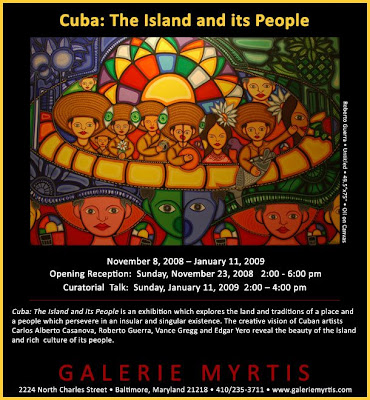The Colors of Wars to Come
Yesterday, when I mentioned the VFMA's Alex Nyernes segment on NPR I dropped the hint that I'd be coming down to Richmond for a day or two. The main reason is that this coming December 12 I will be having an opening of my recent paintings at Richmond's Red Door Gallery.
It is titled "The Colors of Wars to Come," and the work in the show focuses on the series of paintings that I started in the late 90s, initially based on my own military awards earned during my service in the United States Navy, and subsequently (last year) refocused on creating and inventing new awards and campaign ribbons for imagined, forecast or foreseen events of the future.
It is my own visual arts commentary on the futility and near inevitability of foreign policy and unforeseen world events, perhaps predicted (or perhaps avoided) by this line of work.
As I've told the story before many times, this series saw its beginning as a result of the fact that the the McLean Center for the Arts sponsors a very good painting competition every couple of years called "Strictly Painting." It is now in its sixth or seventh iteration.
About a decade ago, around 1999 or 2000, the juror for that year's version of "Strictly Painting" was Terrie Sultan, who back then was the Curator for Contemporary Art at the Corcoran. I thought that this choice was a little odd, as Ms. Sultan, in my opinion back then, was not "painting-friendly."
In fact, with all due respect, I used to blame her for diminishing the Corcoran Biennials, which used to be known as the Corcoran Biennial of Painting. In fact, since then they have been so diluted that I think they no longer exist? (I should ask the Corcoran about this).
Anyway, for many decades they were essentially the only well-known Biennial left in the nation that was strictly designed to get a look at the state of contemporary painting, which was somehow surviving its so called "death."
It was Ms. Sultan who decided to "expand" the Biennial and make it just like all other Biennials: Jack of all trades (genres) Biennials. In the process, depending on what side of this argument you're on, she (a) did a great service to the Corcoran by moving it into the center of the "genre of the moment" scene - like all other Biennials, or (b) gave away the uniqueness of the nation's top painting Biennial title.
I'm aligned with the minority who supports camp (b) but understand those who defend her decision to become just another player in camp (a). Most people think that her decision and drive were the right thing to do in order to bring the Corcoran to a world stage, and perhaps it was. Since I haven't heard any Biennial talk lately, I should check with the Corcoran to see if they intend to continue doing them. If not, I think that the first stake was driven through its heart by Sultan back then.
But I digress.
When she was announced as the juror, I decided to see if I could predict her painting selectivity, sensitivity, process and agenda. It was my thesis that I could predict what Ms. Sultan would pick.
So I made a secret bet, and decided to enter the exhibition with work created specifically to fit what I predicted would be agreeable to Ms. Sultan's tastes. I felt that I could guarantee that I would get into the show because of the transparency of the juror's personal artistic agenda. It is her right to have one; I have them, in fact, we all have them.
I was trained as a painter at the University of Washington School of Art, but around 1992 or so, I had stopped painting and decided to devote myself strictly to my love for drawing.
So by 1999 I had not picked up a brush in several years and that's when I decided to enter this competition, designed to survey the state of painting in our region.
It was my theory that Ms. Sultan would not be in the representational side of painting. It was also clear that she (like many curators including often myself) was seduced by technology in the form of videos, digital stuff and such trendy things.
And therefore I decided to see if I could marry digital "stuff" with painting.
And what I did was the following:
I took some of my old Navy ribbons, and scanned them in to get a digital file. I then blew them up so that the final image was quite pixilated. I then printed about five of them and took slides of the printed sheets of paper.
I then submitted these slides to the competition, but identified them as oil on canvas paintings. My plan was that if accepted, how hard could it be to whip up a couple of paintings after the fact? I titled them with such titles as Digitalism: National Defense and Digitalism: Expeditionary Medal and so on.
From what I was later told, several hundred painters submitted work. And Ms. Sultan selected about only about seven or eight painters in total. And not only was I one of them, but she picked two of my entries.
I was elated! I had hit the nail right on the head! I felt so superior in having such an insight into this intelligent woman's intellect that I (a painter no more) could create competition-specific work to get accepted into this highly regarded show.
And then I began the task of creating the two paintings, using the pixilated images as the guide.
And it turned out to be a lot harder than I thought.
For one thing, I had submitted the "paintings" in quite a large size; each painting was supposed to be about six feet long.
And it didn't take me long to discover that there are a lot of color nuances and hues in an average pixilated image.
And I went through dozens and dozens of rolls of tape as I pulled off the old Washington Color School trick of taping stripes (in my case small one inch square boxes of individual colors - hundreds upon hundreds of them) in a precise sequence to prevent smudging and color peeling, etc.
I painted for at least six hours every day, switching off between paintings to allow the previous day's work to dry off enough to allow a new layer of tape to be applied. I did all the varnishing outside, which usually attracted all the small neighborhood ruffians.
It was incredibly hard work, and I was ever so sorry that I had even gotten this crazy idea. All my nights were consumed.But eventually they were finished and delivered to MPA and Ms. Sultan even wrote some very nice things about them in the exhibition's catalog.
Me? I was in a mix of both vindication and guilt; exhausted but fired up with the often wrong sense of righteousness of the self-righteous.
After the show, I had no idea what to do with them, and they didn't fit my "body of works," but I ended up selling both of them through Sotheby's.
And today, some art collector in South Carolina and another one in Canada, each have one very large, exhausting and handsome oil painting of pixilated naval ribbons hanging in their home, in happy ignorance of the interesting story behind them.
It surprised me a little that I enjoyed this return to painting and I continued to create new work along this series, while slowly walking away from the "exactness" of replicating a pixilated image and drifting towards more towards brushwork and texture.
And then last year I came up upon the concept of inventing new ribbons and awards.
And I created this:
"Iranian Campaign Medal", Oil on Canvas, 24 x 48 inches, c.2007
By F. Lennox Campello (from the Digitalia series)
The above text also "replicates" what a "real" award's wording would look like.The Iranian Campaign Medal was established by Executive Order 13975 signed by the President on 13 January 2012. It may be awarded to American military and naval personnel for participating in prescribed operations, campaigns and task forces ranging in dates from 2 February 2011 to present.
The area of operations for these various campaigns includes the total land area and air space of Iran, and the waters and air space of the Persian Gulf and Indian Ocean within 12 nautical miles of Iranian coastline.
Personnel must be members of a unit participating in, or be engaged in direct support of, the operation for 30 consecutive days in the area of operations or for 60 non-consecutive days provided this support involves entering the area of operations or meets one of the following criteria:
• Be engaged in actual combat, or duty that is equally as hazardous as combat duty, during the operation with armed opposition, regardless of time in the area of operations;
• While participating in the operation, regardless of time, is wounded or injured and requires medical evacuation from the area of operations;
• While participating as a regularly assigned aircrew member flying sorties into, out of, within, or over the area of operations in direct support of the military operations.
One bronze service star shall be worn on the ribbon for qualifying participation during an established campaign. However, that if an individual's 30 or 60 days began in one campaign and carried over into another, that person would only qualify for the medal with one service star. The medal is not awarded without at least one service star.
The executive order provides that service members who qualify for either the Armed Forces Expeditionary Medal or the Armed Forces Service Medal for service in Iran between 2 February 2011 and 13 January 2012, remain qualified for those medals. However, upon application, any such member may be awarded the Iranian Campaign Medal in lieu of the Armed Forces Expeditionary Medal or the Armed Forces Service Medal, but no Service member may be awarded more than one of these three medals for the same period of service in Iran.
The suspension ribbon for the medal's purple and gold colors were suggested by the historical Imperial colors of Iran’s millennial Persian history and the golden sunsets of the Persian Gulf.
At Red Door I plan to exhibit the most recent paintings in this series, as well as half a dozen or so small preparatory watercolors from the late 90s. Here's a video on the creation of some of the works.
The opening reception is December 12, from 6-9PM.
See ya there!























